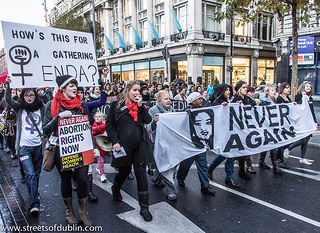Tragic Death Is Consequence Of Ireland's Abortion Policy

A week before her death, the 31 year old expectant mother arrived at the hospital in Galway, complaining of back pain. Doctors quickly realized she was having a miscarriage; however, after watching Halappanavar spend the day in severe pain and determining that the fetus could not survive, they continued to deny their patient the right to have the pregnancy terminated.
For two more days, she was left to bleed and bear excruciating pain—until the point that the fetus’ heart stopped beating. Only then did doctors decide that it was legally and morally permissible to provide Halappanavar the care she desperately needed and remove the fetus from her body.
By then, of course, it was too late. After another four days in intensive care, Halappanavar died of blood poisoning. The doctors bore their piety in silence as the world lost one more victim to the cruel and unscientific campaign against the physical autonomy of women everywhere.
While dying from infection related to miscarriage is admittedly rare, it does happen and therefore constitutes a real risk to the life of any woman having a miscarriage. While Irish law prohibits abortion, a 1992 Supreme Court ruling found that the procedure should be legalized in the case that the woman’s life is at risk if she continues the pregnancy. Like the United States, Ireland is under common law jurisdiction, meaning the rulings of its Supreme Court should be taken as law. In Halappanavar’s case, however, it seems physicians put their own interpretations above that of the Court.
But it is difficult to determine exactly what that interpretation is. In a world where people—particularly the predominantly male bloc that pontificates on the immorality of abortion—are extremely out of touch with the reproductive process and its inherent dangers, it is easy to assume that a woman who lives in a first world country will never have her health, let alone her life, endangered by a pregnancy.
We see this belief manifested in our own country. Just ten days before Halappanavar’s death, Rep. Joe Walsh (R-Ill.) decreed that “with modern technology and science, you can’t find one instance” of an abortion necessary to save a mother’s life.
Walsh’s comment is false. Pregnancy can threaten a woman’s life, as it did for Halappanavar and the thousands of American women who died from complications related to pregnancy in the past two decades, as it does for the silent victims of “honor killings” whose parents take their daugter's pregnancy as a lethal disgrace, and as it does for women who cannot afford to feed both their children and themselves.
The insensitivity showed by Walsh to these women calls to mind the attitude taken toward rape victims by Missouri Rep. Todd Akin in August. Akin, who somehow qualified for the House Science Committee, made headlines by declaring that a woman’s body had mechanisms for rejecting a pregnancy in the case of “legitimate rape.”
Walsh, Akin and any other anti-abortion advocate had better get their facts straight before they start professing on their so-called medical knowledge. Piety does not trump science, nor does it trump a woman’s agency in determining what happens to her own body.
Halappanavar’s cries for help were met with the cold response: “This is a Catholic country.” Halappanavar was not Catholic. She had come to terms with the idea of abortion. She wanted to live.
If being Catholic means leaving women like Savita Halappanavar to die, there should be no Catholic countries. Nor should there be Catholic hospitals, where one out of every six patients in the United States is treated.
Let science, let experience, let a person’s right to choose dictate what a nation’s abortion policy should be—not misinformation.
Let Halappanavar’s death remind the world the brutal reality of what it means to be “pro-life.”
Reach Deputy Opinion Editor Francesca Bessey here.



